Diamonds are more than just dazzling stones; they symbolize love, luxury, and timeless beauty. When selecting the perfect diamond, one crucial factor is its shape. Each diamond shape has distinct features that affect its appearance, cost, and value. Understanding the diamonds shapes pros and cons ensures you make an informed decision.
Round Brilliant: Classic Elegance
The round brilliant is the most popular diamond shape, renowned for its exceptional brilliance and timeless appeal. This shape, designed with 58 facets, maximizes light reflection, making the diamond sparkle intensely.
Pros:
One significant advantage of this shape is its brilliance. The round brilliant is meticulously cut to optimize light performance, ensuring a spectacular shine. Additionally, it is versatile and suits various settings, from solitaire to halo designs. Its universal appeal ensures it remains a safe investment over time.
Cons:
Despite its popularity, the round brilliant diamond tends to be more expensive than other shapes due to high demand and significant rough diamond wastage during cutting. Additionally, any inclusions or imperfections are more visible compared to fancy shapes, necessitating higher clarity grades.
Princess Cut: Modern Sophistication
The princess cut is a contemporary square or rectangular shape with sharp, uncut corners. It appeals to those seeking a modern yet elegant look.
Pros:
One of the key advantages of the princess cut is its brilliance, second only to the round brilliant. Its geometric lines offer a sleek and contemporary appearance, ideal for modern settings. Moreover, the princess cut retains more of the rough diamond during cutting, making it more affordable per carat than round shapes.
Cons:
A drawback is its susceptibility to chipping, especially at the corners, due to its sharp edges. To protect the stone, it’s essential to choose a setting that covers these vulnerable points. Additionally, the color may appear more concentrated at the corners, affecting the stone’s overall uniformity.
Oval Shape: Graceful Brilliance
The oval diamond combines the brilliance of a round shape with an elongated design, giving it a unique, elegant look. This shape is popular for engagement rings, offering a flattering appearance on the finger.
Pros:
An oval diamond creates the illusion of greater size, as its elongated form covers more surface area than a round shape of the same carat weight. Its brilliance is excellent, and the shape tends to make fingers look longer and slimmer. This shape also offers good value for money, often being less expensive than round diamonds.
Cons:
The primary concern with oval shapes is the “bow-tie effect”—a dark shadow across the center. While some bow ties are minimal, others can be noticeable and affect the diamond’s overall beauty. Additionally, symmetry is critical in oval lab made diamonds; any imbalance can be more apparent than in other shapes.
Emerald Cut: Vintage Appeal
The emerald cut is distinguished by its rectangular shape and step-cut facets, offering a hall-of-mirrors effect. This sophisticated shape emphasizes clarity and luster over brilliance.
Pros:
The emerald cut exudes a vintage charm and sophisticated elegance. Its step-cut facets create a unique reflective effect that highlights the diamond’s clarity. The elongated shape can also make the finger appear longer and more slender.
Cons:
Due to its open, broad facets, an emerald cut requires higher clarity; inclusions are more visible compared to other shapes. This shape also has less brilliance than a round or princess cut, which may not appeal to those seeking maximum sparkle.
Pear Shape: Distinctive Elegance
The pear-shaped diamond, resembling a teardrop, combines the best of the round and marquise cuts. It’s known for its unique and sophisticated appearance.
Pros:
A pear-shaped diamond offers versatility; it can be worn with the point facing up or down, creating different visual effects. Its elongated form maximizes carat weight, making the diamond appear larger than round cuts of the same size. Additionally, the distinctive shape stands out, appealing to those who desire a unique ring.
Cons:
Like the oval, the pear shape often exhibits a bow-tie effect, which can detract from its beauty if too prominent. Its pointed tip is prone to chipping, requiring a protective setting. Symmetry is also crucial; an uneven pear shape can appear unbalanced.
Cushion Cut: Romantic Allure
The cushion cut features rounded corners and larger facets, giving it a soft, pillow-like appearance. It combines a vintage feel with modern brilliance.
Pros:
Cushion-cut diamonds offer a romantic, antique charm and excellent light dispersion, creating a stunning, rainbow-like sparkle. They are generally more affordable than round diamonds and hide inclusions well due to their facet pattern.
Cons:
A downside is that cushion cuts can appear smaller than other shapes of the same carat weight. The shape also varies significantly, so finding the perfect proportions may require more effort.
Conclusion
Selecting the ideal diamond shape involves balancing aesthetics, cost, and durability. Each shape has distinct pros and cons, influencing its brilliance, value, and overall appeal. By understanding these factors, you can confidently choose a diamond shape that reflects your style and meets your practical needs. Whether you prefer the classic round brilliant or the unique pear shape, the right choice ensures your diamond remains a cherished symbol of beauty and love.



